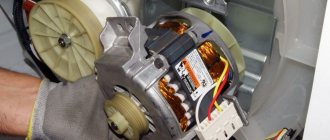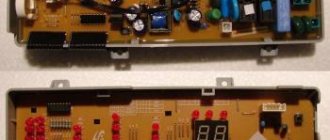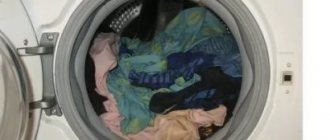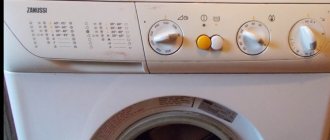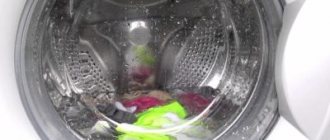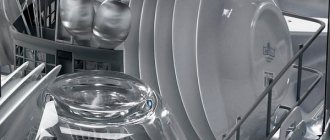If during washing the washing machine takes in water and then immediately drains it, it is impossible not to notice it. The cycle lengthens noticeably, the noise of liquid being flushed down the drain is constantly heard, and things remain dirty.
This can be caused by a variety of reasons, but the most common are:
- when connecting the device to the sewer, the water drain hose was installed incorrectly;
- blockage in the sewer system;
- malfunction of the dirty fluid drain valve;
- damage to the pressure switch;
- The electronic module has failed.
It is recommended to start fixing the problem immediately - a breakdown of this kind can lead to severe wear and tear on the internal elements of the machine or flooding of the apartment.
Incorrect sewer connection
The most common problem that arises after installing new equipment or when moving old equipment to another location.
To check if the hose position is incorrect, you can use two methods:
- Visual inspection. The hose must be fixed above the level at which the washing machine tank is located (approximately half a meter from the floor level or slightly higher). This position eliminates the situation of spontaneous leakage of liquid from the tank. Otherwise, the collected water will be drained, the level sensor will react to a decrease in the water level and send a signal to add new water. The cycle will repeat.
- If you cannot get to the hose, then use the second method to check its correct position. Start the wash cycle and wait to see if the machine starts draining water. If the answer is yes, then the cause of the failure has been identified. Dealing with it on your own is quite simple - you should change the position of the hose in accordance with the standards.
Usually, the machine comes with a special plastic loop that needs to be attached to the back wall of the device and the hose passed through it.
Tank leaking
Due to wear and tear of the material, cracks may form in the tank. If they are small, it is difficult to determine why the washing machine fills with water and immediately drains.
You need to inspect the unit to understand where the liquid is leaking from. Pay attention to the attachment points of the hose, pressure switch, and bolts.
If it turns out that the cause was a violation of the integrity of the plastic in the tank, the only solution to the issue will be its complete replacement. In some cases, they try to fasten the body with an adhesive solution. However, this will only give temporary results.
Cracks can appear in several places at the same time, and if the structure is not replaced in a timely manner, this will lead to the unit breaking down when worn out.
It is not recommended to carry out such repairs yourself. The tank is located deep in the body of the machine; to get to it, you will have to disassemble the washing machine, disconnect the pressure switch, control panel and other devices.
Therefore, if the machine leaks water while washing, call a professional immediately.
Breakdown of the pressure switch
If the device previously worked properly, but now it collects and immediately drains water, then the breakdown may be caused by a failed part.
The pressure switch is responsible for controlling the water level in the tank. When the container is filled to the required level, the sensor gives a signal and the collection of water into the unit is completed.
The pressure switch fails if:
- contacts have oxidized;
- contacts close;
- the membrane is depressurized;
- the pressure pipe is clogged or damaged.
Incorrect operation of the pressure switch can lead to the tank overflowing and water from the machine to leak into the apartment and onto the lower floors.
Solution
Before carrying out any repair work, be sure to disconnect the device from the network.
The water level sensor is located on the rear of the machine. To get it yourself, remove the cover of the device and find the pressure switch. Remove the fasteners, inspect the condition of the part to see if there are any traces of oxidation on the contacts. If they are oxidized, they need to be cleaned.
A sensor tube covered in cracks is a reason to completely replace the unit. Its cost is low, and the process itself is simple.
Procedure for replacing the sensor:
- Disconnect the thin hose going to the compression chamber from the sensor.
- Disconnect the terminals, unscrew the 2 screws securing the pressure switch, and remove it.
- Secure the new one in its place and screw in the screws.
- Connect the terminals.
- Reconnect the thin hose.
- Replace the washing machine cover.
Before assembling the lid, you can carefully, observing safety precautions, start the machine to work without laundry in the drum. If the washing goes well, then the problem is resolved and the case can be assembled. Remember to unplug the device again before starting work. But if the device is still faulty and immediately drains water as soon as it fills, then the reason is different.
Common reasons
Not every cause of a malfunction can be eliminated on your own. This may require special tools and skills. Therefore, if you are not sure that independent efforts will lead to a positive result, it is better to call a specialist.
Incorrect or damaged drain hose installation
In accordance with the standard, the drain hose must be placed so that it is fixed no lower than the tank. This means that you need to measure a distance of 50-60 cm or higher from the floor. If it is not placed high enough, this will lead to the fact that, having collected liquid, the machine will not hold it. The consequence of this is that the washing machine constantly drains water, and the unit begins to refill the tank after the sensor is triggered. This pattern is repeated and causes overload of the pump and motor.
Fixing the problem is not difficult. Using a plastic loop that is attached to the back of the machine, the hose is placed at the height required by the manufacturer. A drain pipe is passed through the loop.
Another malfunction may be a rupture of the hose or wear of the gasket at the point of its attachment. The presence of such a problem is indicated by puddles around the body. The damaged part needs to be replaced, and problems associated with the fact that the washing machine fills and drains water will be eliminated.
Incorrect connection
Several installation methods are used to the general drain:
- To the sink drain. To do this, take a sewer siphon and attach the hose so that it is located higher than the knee.
- To the bathroom, if communication conditions contribute to this.
- Exiting the pipe directly into the sewer system through an outlet. The attachment point must be sealed with a rubber gasket.
The connection error lies in the low position of the hose. If there is no plug, the water drawn into the tank will not heat up, but will flow out through it.
Water level sensor malfunction
The pressure switch is designed to control the fullness of the tank. If the sensor does not operate correctly, it gives an incorrect signal about overflow. The consequence is that the washing machine constantly fills and drains water.
Damage to the sensor includes oxidized contacts, rupture of the pressure switch tube, ingress of foreign objects into it, and violation of the integrity of the membrane.
If you ignore the problem, this will lead to worsening problems with the machine in a short period of time. The result is an overfilled drum and liquid leakage.
Electronic module failure
A sharp drop in power supply voltage in some cases leads to program failure. If this happens, the washing machine takes in water and immediately drains it.
The presence of a digital display makes it easier to identify the problem, because it will show the error code. In some situations, a reboot will solve the problem. You need to unplug the machine and turn it on again.
For a more detailed analysis of a module malfunction, special instruments are required. Therefore, it is recommended to contact a service center or workshop, where they will determine the cause of the failure and, if necessary, replace the module.
Drain valve failure
If the drain valve is not working, the washing machine constantly draws water into the tank. This problem can be resolved by completely replacing the component.
Before starting work, the machine is disconnected from the network. For a device with vertical loading, remove the side panel (the valve is located at the bottom); for a horizontal device, remove the top cover; the required element is located immediately below it. It is necessary to select a valve that is completely identical to the one removed. When purchasing it, also purchase the clamps that will be needed to secure the wires and hoses.
Replacement procedure:
- Find the valve and carefully disconnect the hoses and wires from it.
- Unscrew the screws or bend the latches, depending on the type of valve fixation.
- Turn the part and remove it.
- Install the new valve, secure it, attach hoses and wires, secure them with clamps.
- Replace the panel.
Intake valve failure
The inlet valve operates simultaneously with the pressure switch. This is a component that must control the flow of fluid into the unit.
If during the washing process the machine begins to constantly take in water, it is recommended to check the valve for damage. If the equipment does not have cracks or other visible integrity problems, it is tested using a multimeter. The operating resistance of a working device is 2-4 kOhm.
If faults are found, the valve is completely replaced. It is better to entrust this work to a master who repairs equipment. Solving the problem yourself, you can damage the fasteners, connect the wires incorrectly, which will cause a short circuit.
Electronic module failure
Problems with water intake and drainage may be caused by a malfunction of the electronic module. In this case, the display, if available, displays an error code to help you figure out what the reason is. Try rebooting the device completely and starting it again. If after this the washing machine again drains water immediately after filling, it is recommended to call a specialist. In this case, it will be quite difficult to independently identify and eliminate the problem.
Any breakdown requires prompt repair. If you continue to try to operate the washing machine when it is draining water, you can permanently damage the equipment.
Features of repair of individual brands of washing machines
Indesit
If a washing machine of this brand malfunctions, fills and drains water at the same time, the reason may be in the heating element. You need any multimeter. “Ring” the heating element with this device in the following way:
- Set the multimeter to wiring mode.
- Connect the ends of the cords to the terminals of the heating element.
- If the device monitor does not show any reaction and there are no sound signals, the heating element is broken.
The heating element is located on the back of the machine. To get to it, you need to unscrew the back cover. Replacing the heating element is easy. After installing the new heating element, load the first washing mode and set the required temperature. The self-draining problem should be eliminated.
LG
Using LG cars as an example, we will consider replacing the pressure switch. When this device fails, too much water is drawn into the drum. The laundry turns out poorly wrung out. The display shows the error code “PE”. Replacing the sensor is easy. You need to unplug the power supply and remove the top cover.
The sensor is attached with just one self-tapping screw. First you need to disconnect the terminal and then remove the sensor. Only then disconnect the hose. Checking the pressure switch is easy: when air is blown in, a click is heard. This signal occurs when the sensor is working.
Other reasons for constant drainage of water
If the washing machine worked normally for a long time, and then problems with draining appeared, this most likely means that one of the devices has failed.
We recommend: What is catalytic oven cleaning and what are the advantages of the method?
Inlet valve
The inlet valve, which is installed immediately behind the filler pipe, may have broken. In this case, water will flow into the tank without stopping. When its level exceeds the required value, the sensor (pressure switch) will work and the washing machine will drain the excess. But since the valve does not work and continuously fills with water, the automation will periodically turn on the drain.
With this malfunction, a characteristic noise is constantly heard, which is heard when the machine takes in water. In addition, the drain does not work constantly and you can hear the drain pump turning on and off. Accordingly, the murmur of water entering the sewer is also not heard constantly, but only during operation of the pump.
The inlet valve cannot be repaired; it requires replacement. It is difficult to do this on your own, so it is better to seek help from specialists.
Pressostat
This small part monitors the liquid level in the tank. The information is transmitted to the board, which closes the valve at the right time. If the pressure switch fails, the machine constantly takes in water. When overfilled, the drain does not turn on automatically. Therefore, after filling the tank, the liquid will begin to drain into the sewer by gravity.
If the pressure is strong enough, then there is a high probability of flooding your apartment, as well as the homes of your neighbors below. Therefore, if the washing machine constantly takes in water and its level in the tank is clearly higher than normal, you must immediately turn off the power, forcefully drain the water and resolve the issue of repairing the equipment.
Under no circumstances should you exploit your irreplaceable “helper” if it constantly fills and immediately drains water. Because sooner or later this will lead to serious damage to the washing machine units. And if the tank overfill protection does not work, then water will flood the apartment. Therefore, if such a malfunction is detected, it is better to immediately take measures to eliminate it. This will ensure the operation of the equipment for a long time and save family finances.
Why doesn't the tank hold water?
There are several reasons why a washing machine immediately drains water after filling. The simplest and most easily removable:
The device is not connected to the sewer correctly. If the drain hose is below a certain height (for LG and Hansa it is 50 cm, for Candy and Indesit 60 cm), the flow of water, according to the laws of physics, will constantly flow into the drain automatically. To avoid this, check that the drain is connected to the system correctly. If you find errors, invite a specialist.
There is a blockage in the drain. Because of this, the pressure in the drain pipes increases, and the contents of the drum simply begin to be drawn into them. This breakdown is especially common in old houses, where the sewer lines are outdated, covered with plaque and easily become clogged. You can eliminate the problem by cleaning the pipes
Please note that you cannot continue washing when clogged, despite the fact that the machine quickly draws water back; in this situation, the heating element is loaded too much and may burn out.
Other reasons are due to breakdowns of the internal parts of the washing machine. You need to understand them in more detail to understand how to act.
Set valve stuck
One of the most vulnerable parts is located next to the inlet hose and is responsible for promptly opening or closing the flow from the water supply to the drum. If the intake valve breaks, it continuously pours water into the system, and the device immediately drains it. To find out if this is really the problem, stop the wash and set the drain mode, then press pause and listen. If water continues to flow, the valve has stopped working properly.
If the service center offers you to repair this part, it is better not to agree to it. Technologists from the Ardo and Whirlpool factories claim that any damage to the intake valve is irreversible. It is recommended to install an original spare part.
The water level sensor is faulty
The pressure switch is located closest to the washing tank. It checks how full the tank is and transmits this information to the control unit. If the high pressure tube gives a signal that there is not enough liquid, the device begins to draw it to the required level. If this sensor fails, it will not detect that the drum is full, and the security system will drain the excess.
A professional technician with extensive experience can find out that the problem is in the pressure switch. He must replace this part. Although sometimes you can restore its functionality by sealing the tube.
Drain valve does not work
In some cases, when washing in an automatic machine, a siphon effect may occur. This is the dependence of water flow on pressure in the sewer. Sometimes dirty liquid from the drain can enter the tank of the device or flow out of it uncontrollably. To prevent this from happening, a check valve is installed on the drain channel. It simultaneously protects the drum from leakage and protects the system from dangerous pressure drops.
If the anti-siphon is damaged, it will not work correctly and in some cases can cause continuous drainage into the drain. To fix this, ideally you need to replace it, but before you buy a replacement, try cleaning the filter in the valve or get a professional to do it for you.
Control module error
If all previous reasons are excluded, and the washing machine takes in water and drains it immediately after filling, it means that a failure has occurred in the control unit of the device. It controls all processes and processes all signals from other elements.
If the contacts of the control board are oxidized, foam or moisture gets in, a short circuit or any other damage occurs, it is impossible to predict how this device will behave. It can be extremely difficult to repair, although some repairmen offer such services. Manufacturers Miele and AEG strongly recommend replacing it at the first suspicion of a module defect. Otherwise, the system will not be completely safe from errors.
What to do to avoid machine breakdown?
Washing machine care and maintenance
Proper and timely cleaning of its components is extremely important for reducing the consumption of washing powder and good functionality of the machine. Certain parts of the unit constantly require cleaning, namely: the door seal, the filter, the mesh on the supply pipe.
Proper washing. How to wash bed linen?
Of course, before washing, laundry needs to be sorted. Proper sorting by color and material will help the laundry maintain its original appearance and make life easier for the washing machine.
If the laundry is not dirty and the goal is simply to freshen it, it is necessary to use the cold mode and a short, not complete program. By following these simple rules, you can save energy and take care of your machine drum.
Pressostat repair
When a problem with water intake and drainage occurs due to a broken pressure switch, it needs to be repaired. Features of restoring the functionality of a part depend on the cause of the breakdown.
Oxidation of contacts
Contact oxidation can be eliminated by carefully opening the sensor and cleaning it. This procedure is best performed only if you have experience. Otherwise, it will be easier to completely replace the sensor.
Closing contacts
When pressure is applied to the membrane during washing, the contacts close and open, due to which a signal is sent to the control module about the flow of water.
If the contacts do not operate correctly, it is recommended to replace them.
Membrane depressurization
The formation of cracks and other damage to the membrane leads to water leakage. If the defects are minor, you can eliminate them using a waterproof adhesive solution, but this method does not provide complete protection against water leakage. The optimal solution to the problem is to install a new membrane.
See also
How to paint lacquered furniture at home without removing varnish
Clogged pressure pipe
To clear the drain tube if there is a blockage, you need to disconnect it from the system. Then cleaning agents are poured into the tube and washed with strong water pressure.
Replacement procedure
You need to install a new pressure switch according to step-by-step instructions. It requires you to do the following:
- Unplug the washing machine and turn off the water supply.
- Remove the top cover under which the pressure switch is located.
- Unscrew the fasteners, disconnect the wires from the pressure switch, remove the tube and remove the component.
- Following the reverse procedure, place the new part.
The influence of age and operation of washing machines
As already noted, failure to drain water is one of the most common faults with washing machines. As practice shows, most often this problem appears after about 4-6 years of use, regardless of the brand and model. There are also exceptions: some machines develop a draining problem already after 1-2 years of operation, while others work without problems for 10 years or more. This is due to various features of use and loads on the machine.
On average, with the average household use, the resource of the parts responsible for drainage is enough for 4-6 years of successful operation. However, here it must be taken into account that wear of a variety of elements can lead to disruption of the drain mechanism. Therefore, localization of the breakdown is a particularly important step.
The sewerage system is not functioning
Sometimes the problem is in the central sewer system. More precisely, a blockage occurs or the pressure drops sharply. The latter happens when several residents of the house simultaneously press the drain - the riser overflows, the readings drop, and the liquid from the washer tank is pushed into a common pipe. As a result, the machine empties ahead of time.
You can check whether the sewer system is involved with a simple test. The algorithm for what to do is as follows:
- open any other tap in the apartment;
- evaluate the drainage of collected water (there will be delays in drainage in all rooms).
If there are problems with drainage, then it is necessary to clean the sewer. You can cope with the task either on your own, by pouring special cleaning agents into the riser, or with the help of mechanics. In any case, you will have to wait - the procedure will take a lot of time. In order not to stop the started wash, just unhook the inlet hose from the pipe and lower it into the sink or toilet. The main thing is to thoroughly clean the plumbing fixtures from soap scum and dirt.
Water is leaking from the washing machine - what should I do?
First, you should make sure that the hose has not come off the loops on the back of the machine. You can fix it yourself and thus solve the problem. How to make sure that water is constantly draining from the machine? To do this, just fill the tank with water, start the drain mode and pause the execution. If the water goes away. You will hear a constant noise in the drain hose and siphon.
If the water pressure in the water supply is unstable, it is recommended to install filters with pressure regulators, but this should be done professionally so that the machine fills quickly enough and does not delay the washing time.
How to clear a clogged drain
The most effective way to clear a clogged drain is to use chemicals. Modern substances contain acid or alkali that dissolve accumulated deposits in pipes. To combat the blockage, simply pour the product into the drain, add 0.5 liters of water and rinse the drain with plenty of liquid after 10-15 minutes.
Surgical method or second aid to washing machine
We take all precautions by turning off the water and unplugging the washing machine. In the first step, we disconnect the hoses from the valves (which are located at the back of the machine), since water often remains in the hoses, you need to prepare a container to drain it.
- Unscrew the fastenings of the top cover of the washing machine.
- The wire connectors from the coil tend to have bright colors (like blue and red), similar to blockbusters, you need to remember their location and disconnect them.
- Using pliers, remove the fasteners from each of the four hoses.
- Note the location of the hoses and disconnect them. Keep in mind that they may also contain water, so it's best to have a towel ready.
- We unscrew the screw that secures the valve (it is located at the back) and take out the inlet valve itself.
- We install a new water supply valve by placing it in the bracket and securing it with a screw using a screwdriver.
- We attach the hoses to the connectors and secure them with clamps. Connect the coil wires.
- Reinstall the cover of the washing machine, giving it its original position, and secure the cover with screws behind the machine. We connect the hoses to the new inlet valve.
- We connect the water and plug in the washing machine and check its functionality.
- Open the back cover of the washing machine.
- A temperature sensor and a grounding terminal are connected to the heating element. To remove these wires, use pliers and pull out the connectors.
- And then we take a socket wrench and unscrew the nut that holds the heating element.
- Then use a screwdriver, and then with your hands, using up and down movements, pull the heating element towards you, and together with the heating element you need to pull out the rubber seal.
A screwdriver will help here again.
When we insert a new heating element, you must pay attention to its guide, that is, look into the hole formed from the previous heating element. There will be grooves for the part to fit tightly.
It is best to lubricate the rubber seal of the new heating element with dishwashing gel before inserting it so that it can be inserted easily and quickly.
Then we insert the temperature sensor, tighten the nut and connect the wires.
The drain of the machine is incorrectly connected to the sewer
One of the reasons why the washing machine constantly drains water is that the drain is not connected correctly. Connecting the washing machine should be done by a specialist, but often, in order to save money, the owner does this work himself. It’s good if he follows the advice of the instructions, but if not, then this can result in dire consequences. The height at which the drain hose should be located must be at least 80 centimeters from the floor. If the hose is thrown vertically down, then due to the water pressure, a self-suction effect may occur, and it will constantly drain into the sewer. To avoid this, please read the installation instructions carefully before connecting the machine.
Diagnostics
If breakdowns occur related to draining waste liquid in the washing machine, owners can launch the self-diagnosis function of household appliances. Many models of machines have a similar function, thanks to which the equipment will independently calculate the reason for the malfunction and display it on the information display.
The self-diagnosis function is not provided in all washing machine models. In this case, the owners can independently conduct a kind of revision of the device to find the cause of the malfunction. Let's look at how this can be done.
- First of all, you need to understand that all diagnostic manipulations are allowed to be performed only with the machine disconnected from the network. Try not to forget about this.
- First, you should check the correctness of the set washing program if water accumulates in the drum. As mentioned above, the “Night” or “Hand” washing modes can lead to similar consequences. In such a situation, it is enough to cancel the program and start the drain.
- Carefully inspect the drain hose of the device. The blockage could have formed due to the hose being kinked somewhere. Because of this, excess waste simply cannot go down the drain.
- The siphon could also become clogged if the device is connected through it. To check this, you can disconnect the hose and redirect it to the sink, then start the draining process. If you notice that liquid flows freely from the hose, then the reason lies in the sewer. It is enough to clean it using specialized means or calling a plumber.
If you have completed all of the above steps to diagnose the equipment, but it still does not drain the waste liquid completely (or at all), you can try to restart the device. Disconnect it from the electrical network, let it stand turned off for 15-20 minutes, and then run the program responsible for draining again.
Main causes of failure
There are several reasons why a washing machine may not drain water correctly:
- incorrect connection of the drain to the sewer;
- clogged sewer system;
- drain valve failure;
- malfunction of the water control level;
- failure or breakdown of the software module;
- program failure;
- oxidation of sensor contacts.
Incorrect installation and connection
If the cause is incorrect installation of household appliances, this may indicate that when connecting to the sewer pipes, the technician installed the hose below the required level specified in the instructions for a particular machine. There is no plug in the drain hose to hold the water. It is extremely important that when connecting to the sewerage system, the hose is positioned at a height of at least 60-70 cm. This way, water cannot flow out by gravity.
If the drain point is located at floor level, it must be raised to the desired height, secured in a loop, and then lowered to the drain hole. A natural water seal will eliminate the problem of water drainage. Often the design of a washing machine has a special mount for the hose, which is usually located on the rear panel. If water from the machine is drained into a bathtub or sink, it is important to ensure that part of the drain runs at the height required by the instructions.
valves
The operating principle of this device is as follows:
- they are constantly closed all the time;
- when voltage is applied, they open, and water, under the existing pressure in the pipe, enters the tank.
There is an electromagnetic coil inside the valve, which can burn out over time. The locking mechanism may also become damaged or jammed. As a result, water continuously flows into the machine.
Filling valves. There are also triple and single ones.
It is not advisable to repair the valves, but you need to buy and install new ones. The design and principle of operation itself provides for wear and tear of this device. An attempt at restoration will give a temporary effect, and may ultimately lead to flooding of your and your neighbor’s apartment.
To protect yourself from flooding, you need to purchase an SMA with the full AquaStop system. This is protection against leaks.
Are you unplugging your washing machine?
Oh yes! No
